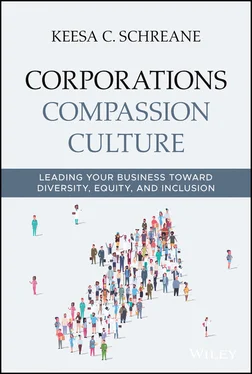In the United States, we're dealing with the remnants of centuries of slavery, resulting in systems designed to oppress people of color socially and economically. Fruits of that system continue to thrive today. For starters, let's take the stratification of races based on a color hierarchy and differential treatment based on skin color. Known as colorism, this prejudicial or preferential treatment of people occurs solely based on their skin color. And although the Black Codes and Jim Crow laws may be unique to the United States, colorism definitely is not. In Westernized societies well beyond the United States, color and colorism is intricately related to race and racism. 26 If there is a hierarchy, then darker-hued people fare worse than lighter-skinned people, regardless of their ethnicity. Where a person lands on the “Blackness” scale could determine social and economic standing. This is our backdrop for disproportionate bias, microaggressions, and racism filtering down to current corporate culture.
Taking this a step further, Blacks have often been set against other minority groups. Most notably, the model minority myth used to wedge a divide between Asian Americans and Blacks. The perceived high level of success among Asian Americans is used as a weapon to downplay racism and the struggles of other minority groups, especially Black Americans. 27 In other words, if “they” (who may be defined Asian or some other ethnic group) can be successful within a certain system, then the problem doesn't lie with a racist system but rather with the groups who are not as successful.
In her famous book, The Color of Success, historian Ellen Wu explores the model minority stereotype. 28 The stereotype is used to cherry-pick the prosperity of some professionally successful historic ethnic minorities. More nefariously, it is used to avoid taking responsibility and making changes toward racial progress in the United States. This continual racism increases the exclusion, lack of compassion, and immobility of Black Americans in the workplace.
Although all historically marginalized groups have unquestionably experienced discrimination and oppression, these experiences can be completely different and unique. We can't have a view of corporate and business success that negates centuries of slavery and the economic loss experienced by Blacks in America.
What is the result of this lack of historical awareness? One impact has been the fact that people of color are tremendously underrepresented in senior roles. There is a sinister scale that weighs who may have it “worse” and why. A study by economist Nathaniel Hilger of Brown University indicates that upward mobility among Asian Americans from the 1970s was due less to the stereotype that Asians “take education more seriously” and more to the simple fact that their fellow Americans became less racist toward them. 29 This shift in public perception and image as nonthreatening, industrious, and law-abiding citizens who seldom complain provided a pathway up the professional ladder.
You can see the same phenomenon at work when the spectacular success of individual members of a minority group is, essentially, weaponized against the group as a whole. Most obviously: “Clearly the United States is not racist because Barack Obama was president for eight years.” This laser-like focus on the individual— so-and-so did it, so why can't you? —is sometimes used as a smokescreen to disguise the many structural obstacles that stand in the way of Black Americans as a group. The idea that Black failure and grievance are not due to racism and structural inequities allows for a segment of White America, including sectors of the corporate world, to avoid the responsibility of addressing racism both inside and outside the workplace. 30
Corporate America's Workplace Racism, Rooted in Slavery
Corporations hoping to understand parallels and patterns between historical dynamics for people of color at work then and now must take a critical look at conduct that may be legal but is still unacceptable. Although some of these behaviors are legal, none of them are ethical . This is where compassion comes into play. Just because something is legal, or even acceptable at one point in time, doesn't mean it's the right thing to do. When corporations and their employees create cultures that accept despicable and pedestrian conduct, despite its legality, it breeds mistrust in the organization specifically and in the institution of business in general.
Large numbers of Blacks and other people of color would likely agree that the words compassion , equality, and inclusion do not accurately reflect their historical or present working experiences. There are too many stories of being systemically shut out of C-suite corporate structures or having to master processes, knowledge, and people management with a humbleness and adroitness not required of their peers. Frustration kicks in when White managers and colleagues are oblivious, or claim to be oblivious, to the ways in which the corporate world is different for Black people.
And let's not forget, these cultural inequities have real-world economic consequences. Marcia Chatelain discusses the concept of racial capitalism . It can be summarized as a level of respect and value afforded people in business based on their race:
Racial capitalism shows ways that we think about how people are racialized. How their racial identities determine their possibilities in the world and determine the ways that they're treated.
So, when we're talking about racial capitalism, we're talking about ways that value or devalue is placed on specific people and their personhood. Racial capitalism has been a healthy way for people to understand the history of slavery and the continued abuse of African Americans even after the end of slavery.
It's also important in racial capitalism to understand how people are treated in other kinds of labor forces in which certain racial and ethnic groups tend to dominate and can also explain other types of exploitation. This includes when we look at Latinx people in agriculture even with certain types of women in domestic work. It helps us understand how value is assigned. 31
Historically, Blacks laid the foundation for the wealth that successful business owners were able to enjoy in the early industrial days up until now, yet they were devalued at every turn. There were approximately 3 million enslaved people in the United States by the time slavery was abolished. These were not paid employees, and they were not willing volunteer workers. They were, what we call in modern days, forced labor.
These humans survived an ongoing intercontinental trafficking scheme that continued for centuries. Herded up and chained, they endured abhorrent overcrowding in the trafficking process, experienced humiliating physical and sanitary conditions, and suffered complete displacement from their culture and kin. They were not lavishly transported by patrons who sought to support their art or craft. They were not “immigrants” looking for “a land of dreams and opportunity,” as was controversially claimed by Dr. Ben Carson in his first speech as Housing and Urban Development Secretary. 32 They were brutalized, maimed, and killed at owners' and supervisors' whims. There was no labor union to help them. There was no regulatory agency to protect them. Aside from emerging and established abolitionists, there were neither international relief organizations nor nongovernmental organizations (NGOs) pouring in massive amounts of money and volunteers to save them.
Although that may sound like ancient history to Whites, it's important to understand that many Black people don't view it that way at all. When I took my first job at a Wall Street firm, elder mentors from church and extended family cautioned me to be mindful that industry “doesn't care a thing about us.” That observation sprang from a number of experiences that are all too common among people of color in the workplace. For example, the experience of training a series of (White) managers who were less qualified and yet, somehow, climbed the ladder significantly faster. The experience of seeing their ideas adopted by and credited to others. False assumptions about their intellect and education when they walked through the door. My elders wanted me to successfully avoid these pitfalls—or at least successfully navigate around them—while keeping my composure and compassion no matter the circumstance.
Читать дальше












